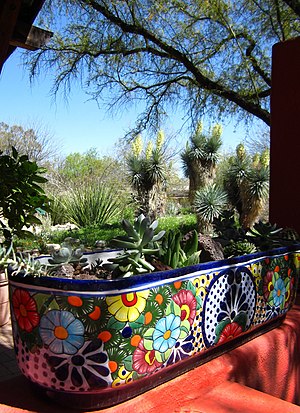Tucson Botanical Gardens
This article needs additional citations for verification. (November 2014) |

The Tucson Botanical Gardens (TBG) is a 5.5 acre (2.2 ha) collection of 20 gardens in the heart of Tucson, Arizona, United States. TBG was selected as number four in USA todays 10best Readers' Choice awards for Best Botanical Garden in 2023. The gardens include the Cactus and Succulent Garden, Barrio Garden, Children's Garden, Herb Garden and many more showing the diversity of plants that can thrive in the Sonoran Desert. There are tropical butterflies from around the world that are featured in the Cox Butterfly and Orchid Pavilion from October-May. In addition to the 20 Gardens there are also rotating art displays, community classes, events and international exhibits.
Hours & Admission[edit]
Summer Hours: June 1- Sept 30
7:30 a.m.-3:30 p.m. Gates close at 3
Fall Hours: Oct 1- May 31
8:30 a.m. -4:30 p.m. Gates close at 4
Admission:
Adults: $15
Students, 62+, Military: $13
Children (4-17): $8
Members, member children, and children under 4: FREE
Edna's Eatery[edit]
Open seven days a week serving Sonoran food and beverages for breakfast and lunch.
Open 7:30 a.m.- 2:00 p.m. in the summer and 8:30 a.m.- 3:00p.m. in the fall.
Butterfly Magic[edit]
Butterfly magic is open in the fall season from October 1- May 31st. It is open seven days a week from 9:30a.m.-3:00p.m. and included with admission. It is a tropical oasis featuring hundreds of butterflies that flutter around you as you walk. There are tropical plants that are not easily seen in the Southwest, and dazzling showy orchids from around the world. The exhibit features 30-50 different butterfly species daily and 100 over the season. The butterfly species range from Costa Rica, South America, Southeast Asia, and Africa. Right outside of the exit of the greenhouse is the Chrysalis exhibit where you can watch butterfly chrysalises hatch all season long.
Dog Days of Summer[edit]
June 1- September 30 leashed dogs are welcomed along with you on your stroll through the Gardens. With a dog membership your canine companion will receive unlimited daily admission during the summer months and a special Tucson Botanical dog tag.
History[edit]
The house was originally the longtime home of Rutger and Bernice Porter. The Porters raised a family, ran a nursery, and participated fully in the life of Tucson. Tucson at that time was an up-and-coming town of about 35,000 people. The earliest buildings on the grounds date to the 1920’s and were constructed of adobe bricks made on site. As the Porter family expanded their home did as well, resulting in three bedrooms, two baths, a sleeping porch, and several beautifully landscaped patios and gardens. The Porters’ garden developed from many planting experiments with a mixture of natives and Mediterranean plants. Over the years, the original garden began to reflect the sturdier choices for the Tucson climate.
Today, the Historical Garden contains many of the original plants from Porter estate including citrus, roses, privet, sweet olive, nandina, pomegranate, Aleppo pine, pyrancantha, iris, chaste-tree, jasmine and other plants of that era. The oasis style represented in this garden is typical of large Tucson gardens dating from the 1920’s to the mid 1960’s. Bernice wanted the beloved property to become a public garden and donated it to the City of Tucson in 1968 while continuing to live in a small apartment on the grounds. In 1974, the Tucson City Council passed Resolution 9384 which stated that the property would be used for the development of a botanical garden to serve as a horticultural center, a sanctuary for wild birds, and as a center for education.
Since it became open to the public, the Tucson Botanical Gardens has renovated and expanded the property while preserving the Porter Family legacy as an important piece of Tucson history. The organization has also expanded its offerings over time by continuing to provide educational resources to the community as well as developing several public events held throughout the year. The 1990’s were a period of rapid growth for the Gardens, evidenced by the additions of an outdoor amphitheater, compost demonstration area, Butterfly Garden and several multicultural exhibits. A new educational building was constructed in 2000 and the popular Butterfly Magic exhibit began in 2004.
In recent years, Tucson Botanical Gardens has increased its commitment to bringing nationally recognized exhibits to Tucson. Beginning in 2015 with the traveling exhibit, Nature Connects, and continuing with hosting the New York Botanical Gardens blockbuster show, Frida Kahlo: Art, Garden, Life, the Gardens have seen an increased number of visitors, membership and volunteer participation In 2019 a 25-year master plan was completed by landscape architect and public garden master planer, Cindy Tyler of Terra Design Studio, LLC. The plan includes purchasing surrounding properties to expand the current footprint of the Gardens, the addition of a new Butterfly & Orchid Pavilion and Event Center, as well as a new 2 acre Children and Family Garden and Education Center.
See also[edit]
References[edit]
- ^ Gardens, Tucson Botanical. "Tucson Botanical Gardens - Your Urban Oasis in the heart of Tucson". Tucson Botanical Gardens. Retrieved 2023-08-03.
